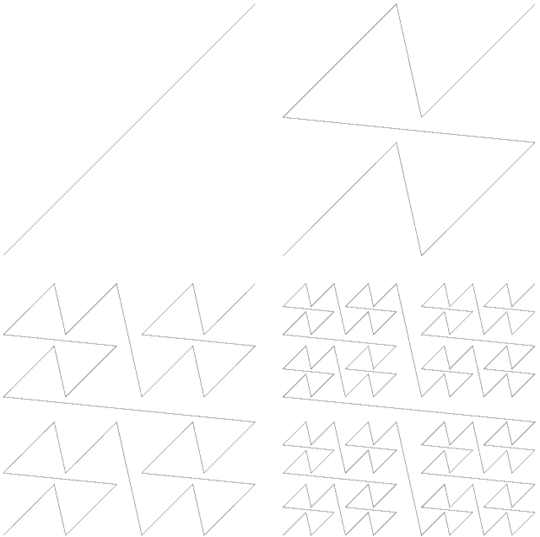0708-1300/Class notes for Tuesday, October 23
| ||||||||||||||||||||||||||||||||||||||||||||||||||||||||||||||||||||||||||||||||||||||||||||||||||||||||||||
Dror's Notes
- You're all invited to my talk today at 12, "Non-Commutative Gaussian Elimination and Rubik's Cube".
- Today's office hours will go 1-2.
- Our handout today is a printout of a Mathematica notebook that demonstrates a "space-filling" Peano curve. Here's the notebook, and here's a PDF version. Also, here's the main picture on that notebook:
Typed Notes
First Hour
Diversion
It is noted that there are no smooth curves that cover the plane. However, there ARE continuous curves that cover the plane.
As an example we consider the continuous function from the unit interval to the unit square that is defined iteratively that looks like the function above.
The construction is done as follows:
draws a diagonal line from the bottom left corner to the top right corner of the unit square. For one breaks the unit interval into 7 sections. The map takes the 1st, 3rd, 5th, 7th sections respectively to a diagonal line in the bottom left, bottom right, top left and top right subboxes respectively where the diagonal line goes from the bottom left to the top right corner of each subbox. The 2nd, 4th and 6th "filler" sections of the unit interval simply draw the lines that map the end of one diagonal to the start of the other. The is defined iteratively. See the diagram above to see what this looks like.
We note that this is obviously continuous and we get uniform convergence to a continuous function into the unit square. As every point in the square get approached arbitrary close to a point in the image of one of the iterates of the function, compactness tells us the entire square is covered.
Definition
A general definition of "locally something" is typically that every point has a neighborhood in which this something property holds. Or perhaps a neighborhood basis where this property holds.
Hence, precisely:
1) A cover is locally finite if every point has a neighborhood V such that V intersects only finitely many 's.
2) A space is paracompact if:
a) Every open cover has a locally finite refinement
b) If a cover is locally finite then so that still covers the space but that
Note: Manifolds are paracompact
Whitney Embedding Theorem
We recall the 3 steps to prove this theorem mentioned last class. It is noted that step three will actually be broken up into two steps:
3a: For an arbitrary we can embed in
3b: We can then embed it in
Proof of Theorem
We had previously proved most of part 1, but what we still had to show was that such partitions of unity actually exist.
Reminder of Definition:
A partition of unity subordinate to is a collection of functions such that:
1) Supp
2)
Claim: If is a chart and is compact then we can find a function that is compact and supp
Proof of Claim
Because we are inside a chart, it is enough to just do this in .
For every we can find a radius r such that . By compactness we can take only finitely many such p's. Hence, cover K.
We want to put a bump function of each ball and sum them up to give us our .
Let for x<r and 0 otherwise.
Now let
Q.E.D
Theorem
On a manifold, given an open cover, you can find a partition of unity subordinate to a locally finite refinement of it.
Proof
WLOG, the cover is by charts and each one is bounded and the cover is locally finite
By paracompactness, find such that and . By the previous claim can find supp
Now consider . This is a finite sum.
By local finiteness, it is smooth and so we define
Q.E.D. for part 1 of Whitney
Second Hour
coming soon to a wikipedia near you.

































